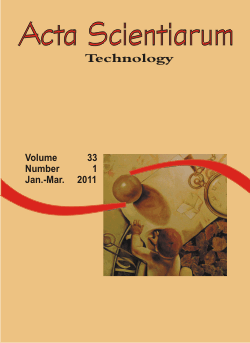<b>Residual fatty and oil production in Arroio do Tigre town, Rio Grande do Sul State, aiming biodiesel production</b> - doi: 10.4025/actascitechnol.v33i1.8823
DOI:
https://doi.org/10.4025/actascitechnol.v33i1.8823Keywords:
Biodiesel, waste oils and fats, environmental perception, total polar materialAbstract
The present work had as its goals to recognize the production condition of waste oils and fats in the urban area of small towns in order to define actions that will reduce the environmental impact of this activity in public places and homes. The city where the study was accomplished was Arroio do Tigre (Rio Grande do Sul - Brazil), which has 5511 inhabitants. We used a sample of the population that was divided into two groups: houses and establishments that produce food for frying process. The survey aimed to gather the population's attitudes and perceptions about the waste oils and fats. We also analyzed the frying oil from two restaurants and produced biodiesel. The results showed that most of the interviewed people give an inadequate destiny to the waste oils and fats. It is also noticed that the higher the education level, the greater clarification of the environmental issues and greater availability for the installation of collection programs for waste oil and fats through some encouragement. In relation to biodiesel produced in pilote scale from restaurant waste oil with CH3ONa catalyst was obtained 96.6% of conversion and the quality parameters were as National Petroleum Agency (ANP).Downloads
Download data is not yet available.
Downloads
Published
2011-02-04
How to Cite
Schneider, R. de C. de S., Santos, E. dos, Krise, D. J., & Lipke, R. J. (2011). <b>Residual fatty and oil production in Arroio do Tigre town, Rio Grande do Sul State, aiming biodiesel production</b> - doi: 10.4025/actascitechnol.v33i1.8823. Acta Scientiarum. Technology, 33(1), 71–79. https://doi.org/10.4025/actascitechnol.v33i1.8823
Issue
Section
Chemistry
License
DECLARATION OF ORIGINALITY AND COPYRIGHTS
I Declare that current article is original and has not been submitted for publication, in part or in whole, to any other national or international journal.
The copyrights belong exclusively to the authors. Published content is licensed under Creative Commons Attribution 4.0 (CC BY 4.0) guidelines, which allows sharing (copy and distribution of the material in any medium or format) and adaptation (remix, transform, and build upon the material) for any purpose, even commercially, under the terms of attribution.
Read this link for further information on how to use CC BY 4.0 properly.











8.png)




